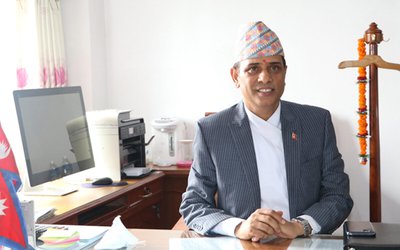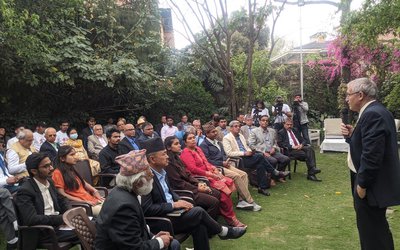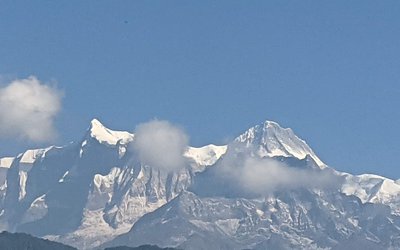“Civil service is not supporting us,” said Prime Minister Madhav Kumar Nepal a few months back in an interaction with the senior government officials at his office. “I am not satisfied with the performance of bureaucracy.”
While pointing out the need to take a drastic step to restructure the bureaucracy, UCPN-Maoist leader Pushpa Kamal Dahal Prachanda used this refrain: “There is rampant corruption in the Nepalese bureaucracy and it is not functioning as per the expectations of a New Nepal. We want independent and impartial bureaucracy which can serve the interests of Nepal and the Nepalese people.”
Deputy Prime Minister Bijaya Kumar Gachchhadar’s take on bureaucracy was that it was “haunted by the ghosts of the past” and needed to “change its traditional mindset.”
He advised taking necessary steps if it required restructuring and reforms.These leaders are not the only ones holding such views of the civil service. Other politicians, civil society members and common people are also heard making critical comments on the way Nepali bureaucracy functions below par.
Alright, its service delivery may not be perfect. Nevertheless, it is serving the people at the grassroots by issuing birth and death certificates, and providing recommendation letters and stuff.
Surviving all turmoil, the bureaucracy is visibly present at the policy level as well. Bureaucracy cannot replace political institutions, but in Nepal, it is at least filling some space in a political vacuum created by an unstable situation.
There are many contrasts and contradictions in the service delivery system. At tax offices, the services are most sophisticated and computerized. Transport management is semi-computerized. Land revenue, district administration and village development committees are in the same mundane manual routine of decades ago. VDC secretaries, for example, still issue handwritten certificates.
Nevertheless, be they automated, semi-automated or non-automated, Nepalese offices are providing services despite their degrees of efficiency and discrimination among the service seekers.
Politicization of Bureaucracy
Politicization of civil service is not a new phenomenon in Nepal. Like it or not, politics and bureaucracy are twin brothers. What is ideally desired is to limit political intervention in bureaucracy to the tolerable levels.
Political influence always prevails at the time of promotion and transfer of secretaries. Following the establishment of new democracy, the selection of secretaries is happening on the whims of the concerned ministers.
‘’Despite expectations from the changes, the transition witnessed painful political turbulence emanating from inter-party conflict and intra-party feuds which have been reflected in the administrative efficiency. Frequent changes in the government and the political instability have had their consequences on the reform endeavors. As a result, the administration could not nurture the democratic administrative culture to overcome the existing governance issues and the task of transforming the civil service from a non-responsive one is, therefore, difficult,” writes Dr. Madhunidhi Tiwari, a renowned administration expert and former member of the Public Service Commission, in an article.
Instead of competence, experience and capability, what counts in civil service so much is political influence.“This is the tragic part of Nepal’s current bureaucracy, many capable secretaries don’t have work,” a secretary said on condition of anonymity.
Others see political intervention is not new at all. “You cannot separate administration and politics. Frankly speaking, civil service is the helping hand of politicos. You cannot say that you can make administration hundred percent clean and away from politics. We can only ascertain a tolerable limit to it,” said former secretary Chandi Shrestha.
“At present the country has been passing through a transitional phase and the level of political intervention will be more. In many cases, the bureaucracy needs to guide politics because it is a permanent and stable government.”
With a strength of 80,000 employees, one of the problems with Nepal’s bureaucracy is frequent disturbance in institutional mechanism. Although Nepal Civil Service Act 1956 was scrapped in 1996 without any single amendment, Nepal Civil Service Regulation 1965 was amended 30 times. Interestingly, the only clause amended related to promotion. Similarly Nepal Civil Service Act 1993 was also amended twice but both the times the amendments pertained to promotion.
Even the proposal related to the third amendment, which is still under discussion, is related to promotion. Following the political change of 2006, the act was amended again introducing clause 24 (d) which made any civil servant working 15 years in a position eligible for automatic promotion. Despite their promotion, they were not given the jobs they were promoted for. There are more than 15000 such employees who are going to be chronic problems for Nepal’s civil service.
Criticism Against Bureaucracy
When all political machineries are virtually defunct and no improvement in political order is in sight, the civil service, whether one likes or not, is there to provide whatever limited stability. Then why is it under such a severe criticism?
Politicians’ criticism is understandable as bureaucracy always creates hurdles when they try to override the rules and regulations and try to impose their own vested interests. In some cases, some officials serve the interests of ministers but they always abide by the decision making process. During the last five decades, Nepal’s civil service has seen many ups and downs and crucial phases to the extent of dismantling but it survived all the time.
Nepal’s stable and strong bureaucratic system always created hurdle against any forces. Through their own experiences, senior bureaucrats guide politicians on several matters. As bureaucracy always stands for cause and system, nobody likes it.
Two recent examples have shown that Nepal’s civil service has certain inbuilt capacities to resist with ministers if there something goes wrong. The dispute between foreign minister Sujata Koirala and bureaucrats of her ministry over the Machine Readable Passport and Energy Minister Dr. Prakash Sharan Mahat’s dispute with his senior bureaucrats and other officials at the Ministry of Energy on the appointment of chairman in a project are a testimony of a bureaucracy at work.
Despite strong opposition from deputy prime minister Sujata Koriala, the Foreign Ministry finally signed an agreement for MRP with a French company and minister Dr. Mahat was himself compelled to write the dismissal to one of the appointees after the bureaucrats declined his order to issue dismissal. The disputes are now in Supreme Court.
Nepal’s History of Bureaucracy
Nepal’s bureaucracy entered the modern era after the revolution of 1951. It started functioning without any basic infrastructure and institutions required to run a modern bureaucracy. It had to wait for five years till 1956 to get recognition by law. Coping with all turmoil and changes, by now, Nepal’s civil service, has established itself as an institution.
From the first interim period to the short era of multi-party democracy, then a rigid partyless panchayat to open multiparty democracy and from multiparty to present political system without any values, Nepal’s Civil Service has made much progress.
The civil service has seen more time of trouble and instability than stability. Whoever may have come to power, they always tried to shake the very basic foundation in the name of reforms. This happened in all the processes of change: 1950, 1961, 1990, and 2006.
The Nepal Civil Service Act, passed in 1956, classified all civil employees of the government into two categories: gazetted service and non-gazzetted service. Gazetted services included all services prescribed by the government by notification in the Nepal Raj Patra, the government gazette.
The bureaucracy is now categorized under several services, education, judicial, health, agricultural, medicine, account and miscellaneous services.
Reforms after Reforms
Started with good objective, Nepal’s administrative reforms ended in shaking civil service all the time. Several decisions were made in the name of reforms to make it efficient and competent. In these entire shakeups, what civil service lost was discipline, memory and sense of certainty. Whenever the reforms were introduced, a couple of thousand employees got retirements. The exit of a large number of employees not only created a sense of instability among civil servants but also caused a loss to state’s memory.“The reform agenda was often introduced without understanding the value, culture and ethos of the country,” said former secretary Shreeman Shrestha, who was dismissed in the administrative reforms of 1996 and reinstated by the court later. “What politicians have done is they have shaken the bureaucracy all the time.”
Nepal’s History of Bureaucracy
Nepal’s bureaucracy entered the modern era after the revolution of 1951. It started functioning without any basic infrastructure and institutions required to run a modern bureaucracy. It had to wait for five years till 1956 to get recognition by law. Coping with all turmoil and changes, by now, Nepal’s civil service, has established itself as an institution.
From the first interim period to the short era of multi-party democracy, then a rigid partyless panchayat to open multiparty democracy and from multiparty to present political system without any values, Nepal’s Civil Service has made much progress.
The civil service has seen more time of trouble and instability than stability. Whoever may have come to power, they always tried to shake the very basic foundation in the name of reforms. This happened in all the processes of change: 1950, 1961, 1990, and 2006.
The Nepal Civil Service Act, passed in 1956, classified all civil employees of the government into two categories: gazetted service and non-gazzetted service. Gazetted services included all services prescribed by the government by notification in the Nepal Raj Patra, the government gazette.
The bureaucracy is now categorized under several services, education, judicial, health, agricultural, medicine, account and miscellaneous services.
Reforms after Reforms
Started with good objective, Nepal’s administrative reforms ended in shaking civil service all the time. Several decisions were made in the name of reforms to make it efficient and competent. In these entire shakeups, what civil service lost was discipline, memory and sense of certainty. Whenever the reforms were introduced, a couple of thousand employees got retirements. The exit of a large number of employees not only created a sense of instability among civil servants but also caused a loss to state’s memory.“The reform agenda was often introduced without understanding the value, culture and ethos of the country,” said former secretary Shreeman Shrestha, who was dismissed in the administrative reforms of 1996 and reinstated by the court later. “What politicians have done is they have shaken the bureaucracy all the time.”
With all reforms, jolts and trouble, one of the miracles of Nepal’s civil service, which has many lacunas and lapses, is that it survived all major political earthquakes and tsunamis.- TANAHU HYDROPOWER PROEJCT: A Significant Achievement
- Apr 15, 2024
- AMBASSADOR HANAN GODAR: Sharing Pain With A Nepali Family
- Mar 30, 2024
- VISIT OF KfW AND EIB TO NEPAL : Mission Matters
- Mar 25, 2024
- NEPAL BRITAIN SOCIETY: Pratima Pande's Leadership
- Mar 24, 2024
- NEPAL ARMY DAY: Time To Recall Glory
- Mar 15, 2024
















